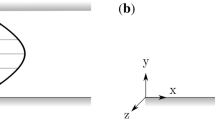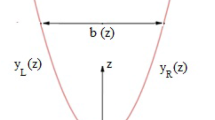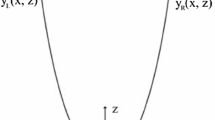Abstract
When the stability of a sharply stratified shear flow is studied, the density profile is usually taken stepwise and a weak stratification between pycnoclines is neglected. As a consequence, in the instability domain of the flow two-sided neutral curves appear such that the waves corresponding to them are neutrally stable, whereas the neighboring waves on either side of the curve are unstable, in contrast with the classical result of Miles (J Fluid Mech 16:209–227, 1963) who proved that in stratified flows unstable oscillations can be only on one side of the neutral curve. In the paper, the contradiction is resolved and changes in the flow stability pattern under transition from a model stepwise to a continuous density profile are analyzed. On this basis, a simple self-consistent algorithm is proposed for studying the stability of sharply stratified shear flows with a continuous density variation and an arbitrary monotonic velocity profile without inflection points. Because our calculations and the algorithm are both based on the method of stability analysis (Churilov J Fluid Mech 539:25–55, 2005; ibid, 617, 301–326, 2008), which differs essentially from usually used, the paper starts with a brief review of the method and results obtained with it.










Similar content being viewed by others
Notes
They do undoubtedly exist because a homogeneous flow (J = 0) is stable according to Rayleigh’s theorem (Drazin and Reid 2004).
The flow may have other pycnoclines as well.
In this case, we find \(\phantom {\dot {i}\!}c_{i}<0\) which formally means that waves are damped. It is well-known, however, that if Eq. 1 is treated as a limit (at large Reynolds numbers) of the equations that take into consideration dissipative processes (viscosity, heat conduction, salt diffusion, and so on), then only unstable and neutral solutions of Eq. 1 (obtained with bypassing the points of phase resonance by the Landau rule, see Drazin and Reid 2004) provide the limit for dissipative solutions. The solutions with \(\phantom {\dot {i}\!}c_{i}<0\) are not such a limit and the corresponding waves do most likely not exist.
We emphasize that if \(\phantom {\dot {i}\!}M>2\), for each \(\phantom {\dot {i}\!}s\ge 1\) there are its own curve \(\phantom {\dot {i}\!}U_{M}^{(s)}\), and its own curve \(\phantom {\dot {i}\!}U_{M-1}^{(s)}\), and so on, despite to the fact that the phase velocity \(\phantom {\dot {i}\!}c=U_{m}\) is the same at different \(\phantom {\dot {i}\!}s\).
Strictly speaking, when \(\phantom {\dot {i}\!}\text {Im}\, c\ne 0\) the eigenfunction has no nodes and, with its proper normalization, there would be more correct to tell about zero of its real part.
References
Alexakis A (2005) On Holmboe’s instability for smooth shear and density profiles. Phys Fluids 17:084103
Alexakis A (2007) Marginally unstable Holmboe modes. Phys Fluids 19:054105
Andronov A A, Fabrikant A L (1979) Landau damping, wind waves, and whistle. In: Gaponov-Grekhov A V (ed) Nonlinear Waves. Moscow, Nauka, pp 68–104 (in Russian)
Carpenter J R, Tedford E W, Rahmani M, Lawrence G A (2010) Holmboe wave fields in simulation and experiment. J Fluid Mech 648:205–223
Caulfield C P (1994) Multiple linear instability of layered stratified shear flow. J Fluid Mech 258:255–285
Churilov S M (2005) Stability analysis of stratified shear flows with a monotonic velocity profile without inflection points. J Fluid Mech 539:25–55
Churilov S M (2008) Stability analysis of stratified shear flows with a monotonic velocity profile without inflection points. Part 2. Continuous density variation. J Fluid Mech 617:301–326
Churilov S M (2010) Three-dimensional instability of shear flows with inflection-free velocity profiles in stratified media with a high Prandtl number. Izv Atmos Ocean Phys 46:159–168
Churilov S M (2016) Stability of shear flows with multilayered density stratification and monotonic velocity profile having no inflection points. Geophys Astrophys Fluid Dyn 110:78–108
Drazin P G, Reid W H (2004) Hydrodynamic stability, 2nd edn. Cambridge University Press, Cambridge
Fabrikant A (2002) Plasma-hydrodynamic analogy for waves and vortices in shear flows. In: Aurégan Y, Maurel A, Pagneux V, Pinton J-F (eds) Sound-flow interactions. Lecture Notes in Physics, vol 586. Springer, New York, pp 192–209
Fedorov K N (1978) The thermohaline finestructure of the ocean. Pergamon Press, Oxford
Hogg A M, Ivey G N (2003) The Kelvin-Helmholtz to Holmboe instability transition in stratified exchange flows. J Fluid Mech 477:339–362
Holmboe J (1962) On the behaviour of symmetric waves in stratified shear layers. Geofys Pub 24:67–113
Howard L N (1961) Note on a paper of John W. Miles. J Fluid Mech 10:509–512
Huppert H E (1973) On Howard’s technique for perturbing neutral solutions of the Taylor–Goldstein equation. J Fluid Mech 57:361–368
Korchagin N N, Monin A S (2004) Mesooceanology. Nauka, Moscow (in Russian)
Miles J W (1961) On the stability of heterogeneous shear flows. J Fluid Mech 10:496–508
Miles J W (1963) On the stability of heterogeneous shear flows. Part 2. J Fluid Mech 16:209–227
Redekopp L G (2001) Elements of instability theory for environmental flows. In: Grimshaw R (ed) Environmental stratified flows. Kluwer, Dordrecht, pp 223–281
Smyth W D, Peltier W R (1989) The transition between Kelvin-Helmholtz and Holmboe instability: an investigation of the overreflection hypothesis. J Atmos Sci 46:3698–3720
Smyth W D, Peltier W R (1990) Three-dimensional primary instabilities of a stratified, dissipative, parallel flow. Geophys Astrophys Fluid Dyn 52:249–261
Smyth W D, Winters K B (2003) Turbulence and mixing in Holmboe waves. J Phys Oceanogr 33:694–711
Squire H B (1933) On the stability of three-dimensional disturbances of viscous flow between parallel walls. Proc Roy Soc Lond A 142:621–628
Tedford E W, Carpenter J R, Pawlowicz R, Pieters R, Lawrence G A (2009) Observation and analysis of shear instability in the Fraser River estuary. J Geophys Res 114:C11006
Thorpe S A (1969) Neutral eigensolutions of the stability equation for stratified shear flow. J Fluid Mech 36:673–683
Timofeev A V (1971) Oscillations of inhomogeneous flows of plasma and liquids. Sov Phys Uspekhi 13:632–646
Turner J S (1973) Buoyancy effects in fluids. Cambridge University Press, Cambridge
Yoshida S, Ohtani M, Nishida S, Linden P F (1998) Mixing processes in a highly stratified river. In: Imberger J (ed) Physical processes in lakes and oceans. AGU series coastal and estuarine studies, vol 54, pp 389–400
Acknowledgements
The author is grateful to the anonymous Reviewer for helpful comments and suggestions.
Funding
The study was carried out with budgetary funding of Basic Research Program of the state academies of Russia, Project No. II.16.
Author information
Authors and Affiliations
Corresponding author
Additional information
Responsible Editor: Gregory Reznik
This article is part of the Topical Collection on the International Conference “Vortices and coherent structures: from ocean to microfluids”, Vladivostok, Russia, 28–31 August 2017
Appendices
Appendix A: Stability equation without the Boussinesq approximation
For the flow described in Section 2, linearized Euler and continuity equations take the form (the prime denotes the \(\phantom {\dot {i}\!}z\)-derivative)
where
Putting \(\phantom {\dot {i}\!}u=-\partial \psi /\partial z,\ \ w=\partial \psi /\partial x\) and eliminating \(\phantom {\dot {i}\!}\rho _{1}\), one can easily arrive at the equation
Let \(\phantom {\dot {i}\!}\rho _{*}=\rho _{0}(0)\). Multiplying this equation by \(\phantom {\dot {i}\!}\rho _{0}/\rho _{*}^{2}\) and introducing a new variable such that \(\phantom {\dot {i}\!}\mathrm {d}{\zeta }=\rho _{*}\mathrm {d} z/\rho _{0}\) and \(\phantom {\dot {i}\!}{\zeta }= 0\) when \(\phantom {\dot {i}\!}z = 0\), we obtain
and then, for a single harmonic \(\phantom {\dot {i}\!}\psi (x,{\zeta },t)=f({\zeta })\exp \) \(\phantom {\dot {i}\!}[ik(x-ct)]\),
where \(\hat {{\Omega }}^{2}({\zeta })=-(\hat {g}/\rho _{*})\mathrm {d}\rho _{0}/\mathrm {d}{\zeta }\equiv \hat {J} \hat {n}({\zeta })\) is the squared modified buoyancy frequency, \(\phantom {\dot {i}\!}\hat {J}\) is the modified bulk Richardson number, and \(\phantom {\dot {i}\!}\hat {n}({\zeta })=n(z)\rho _{0}(z)/\rho _{*}\). Notice that since \(\phantom {\dot {i}\!}\rho ^{\prime }_{0}<0\), \(\mathrm {d}^{2}U/\mathrm {d}{\zeta }^{2}=\rho _{0}\left (\rho ^{\prime }_{0}U^{\prime }+\rho _{0}U^{\prime \prime }\right )/\rho _{*}^{2}<0\) and the velocity profile in terms of \(\phantom {\dot {i}\!}{\zeta }\) is inflection-free as well. Moreover, in the ocean \(\phantom {\dot {i}\!}1-\rho _{0}(z)/\rho _{*}\ll 1\) and it is easily seen that Eq. 28 is closely similar to and has much the same spectral properties as Eq. 1.
Appendix B: Stability of waves with CL at the periphery of a pycnocline
We construct the solution of Eq. 1 using the method of matched asymptotic expansions. Namely, we match the solutions of the Rayleigh Eq. 5 outside the pycnoclines (so-called outer solutions) to approximate solutions of the Taylor–Goldstein Eq. 1 inside pycnoclines (so-called inner solutions). In searching for the latter, a distinction should be made between a regular inner problem when CL is outside the pycnoclines or at a far periphery of one of them (|z c − z m |≫ ℓ) and a singular inner problem when CL lies inside the \(\phantom {\dot {i}\!}m\)-th pycnocline (|z c − z m | = O(ℓ)). The analysis of the singular problem carried out by Churilov (2008) is quite sufficient for our purposes, whereas that of the regular problem will be extended below to the case when CL enters the pycnocline’s periphery.
1.1 Solutions of the Rayleigh equation and their properties
Since \(\phantom {\dot {i}\!}U^{\prime \prime }(z)<0\) everywhere, for any \(\phantom {\dot {i}\!}k\) and \(\phantom {\dot {i}\!}c\) Eq. 5 has no solution that satisfies both boundary conditions indicated in square brackets. In other words, the solution \(\phantom {\dot {i}\!}F(z)\) vanishing at \(\phantom {\dot {i}\!}z = 0\) and the solution \(\phantom {\dot {i}\!}G(z)\) bounded at infinity are linearly independent. Let us specify them imposing the conditions
They are analytic functions in a band \(\phantom {\dot {i}\!}-b<\text {Im}\, z<0\) of complex \(\phantom {\dot {i}\!}z\)-plane and are related by
With a real phase velocity \(\phantom {\dot {i}\!}c\) (for detail, see Churilov 2016),
Hence, for any \(\phantom {\dot {i}\!}0<z_{1}<z_{2}\),
when \(\phantom {\dot {i}\!}z_{c}\) does not lie between \(\phantom {\dot {i}\!}z_{1}\) and \(\phantom {\dot {i}\!}z_{2}\), i.e., when either \(\phantom {\dot {i}\!}z_{c}<z_{1}\) or \(\phantom {\dot {i}\!}z_{c}>z_{2}\). In addition, note that (see Eq. 37 in Appendix CC for definition) \(\phantom {\dot {i}\!}\varphi _{A}(z)=U^{\prime }_{c}\left [F(z)G_{c}-F_{c}G(z)\right ]\).
1.2 Regular inner problem, dispersion equations, and stability analysis
In accordance with boundary conditions, outer solutions of Eq. 1 can be written as \(\phantom {\dot {i}\!}g(z)=\text {CF}(z)+\text {EST}\) between the bottom and the lower pycnocline, \(\phantom {\dot {i}\!}g(z)=G(z)+\text {EST}\) above the pycnoclines, and \(\phantom {\dot {i}\!}g(z)=C_{1}F(z)+C_{2}G(z)+\text {EST}\) between the pycnoclines where \(\phantom {\dot {i}\!}C\), \(\phantom {\dot {i}\!}C_{1}\), and \(\phantom {\dot {i}\!}C_{2}\) are constant, and EST stays for exponentially small terms due to “stratification remnants.”
Now, let us find the solutions of the regular inner problem assuming that \(\phantom {\dot {i}\!}|z_{c}-z_{m}|\gg \ell \) and the wavelength is not too small (kℓ ≪ 1). In each pycnocline, we introduce its own internal variables
where \(\phantom {\dot {i}\!}N_{m}(Z_{m})\) satisfies the equalities (compare with Eq. 2)
Substituting into Eq. 1 yields the equation of the inner problem for the \(\phantom {\dot {i}\!}m\)-th pycnocline,
Its solution is sought in the form of an expansion
and at \(\phantom {\dot {i}\!}\ell \ll |z-z_{m}|\ll 1\) is matched to solutions \(\phantom {\dot {i}\!}g_{m\pm }(z)\) of Eq. 5 to the right (+) and to the left (−) of the pycnocline.
The scale of the outer solution variation is \(\phantom {\dot {i}\!}O(1)\), while that for the inner solution is \(\phantom {\dot {i}\!}O(\ell )\), therefore, in the leading order, we obtain the eigenvalue problem as follows:
Since we study only the basic modes whose eigenfunctions have no nodes inside the pycnoclines, the solution is trivial, \(\phantom {\dot {i}\!}R_{m}^{(0)}= 0\) and \(\phantom {\dot {i}\!}h_{m}^{(0)}(Z_{m})=A_{m}=g_{m-}(z_{m})\). In the order \(\phantom {\dot {i}\!}O(\ell )\), we arrive at the equation
and integrating it with matching to \(\phantom {\dot {i}\!}g_{m-}(z)\) obtain
Next, in the order \(\phantom {\dot {i}\!}O(\ell ^{2})\) we have
and
Now, taking into account Eq. 32, we are able to write down the conditions for matching the outer solutions through the pycnocline (compare with Eq. 6),
where
Substituting outer solutions in Eq. 33 and eliminating coefficients at \(\phantom {\dot {i}\!}F(z)\) and \(\phantom {\dot {i}\!}G(z)\), we arrive at the dispersion equation. For the flow with a single pycnocline centered at \(\phantom {\dot {i}\!}z=z_{1}\), we obtain (compare with Churilov 2005, Eq. (2.5))
and when there are two pycnoclines, centered at \(\phantom {\dot {i}\!}z_{1}\) and \(\phantom {\dot {i}\!}z_{2}\), the equation has the form (compare with Churilov 2016, Eq. 5)
Using Eq. 35, let us consider the stability of the wave with CL entering a periphery of the \(\phantom {\dot {i}\!}m\)-th pycnocline. More precisely, let \(\phantom {\dot {i}\!}|z_{c}-z_{m}|=O(\ell ^{1/2})\gg \ell \). In this case, the Richardson number \(\phantom {\dot {i}\!}J\) can either remain of the order unity or become small, \(\phantom {\dot {i}\!}J=O(\ell )\). We start with the upper pycnocline assuming that \(\phantom {\dot {i}\!}|c-U_{2}|\ll 1\). If \(\phantom {\dot {i}\!}J=O(1)\), we arrive at the equation
which goes into the equation of the neutral curve \(\phantom {\dot {i}\!}U_{2}\) (see Churilov2016, Eq.7b) as \(\phantom {\dot {i}\!}\ell \to 0\) (and, respectively, \(\phantom {\dot {i}\!}c\to U_{2}\)). With Eq. 31 we obtain
When \(\phantom {\dot {i}\!}z_{c}>z_{2}\), the right-hand side of this equation is positive (see Eq. 30) so that \(\phantom {\dot {i}\!}\text {Im}\, c = 0\). If, however, \(\phantom {\dot {i}\!}0<z_{2}-z_{c}\ll 1\),
Since \(\phantom {\dot {i}\!}\phi ^{\prime }(z_{c}+ 0)<0, \text {Im}\, c>0\) so that corresponding waves are unstable, and the instability region containing them is bounded above by the neutral curve \(\phantom {\dot {i}\!}U_{2-}\) described by the equation \(\phantom {\dot {i}\!}J=J_{U_{2-}}(k)\) which follows from Eq. 36.
If, however, \(\phantom {\dot {i}\!}J=O(\ell )\) and \(\phantom {\dot {i}\!}|c-U_{2}|=O(\ell ^{1/2})\), Eq. 35 reduces to the dispersion equation (compare with Eq. 34)
for the flow with a single pycnocline centered at \(\phantom {\dot {i}\!}z_{2}\) and the effective Richardson number \(\phantom {\dot {i}\!}J_{\text {eff}}=p_{2}J\). As \(\phantom {\dot {i}\!}\arg (F_{2}G_{2})\approx -\chi _{0}>0\), the waves with z c > z2 are unstable. To find the exact position of the stability boundary, we need to solve the singular inner problem, but it does not differ from that solved by Churilov (2008), except for the replacing \(\phantom {\dot {i}\!}J\) by \(\phantom {\dot {i}\!}J_{\text {eff}}\). Based on the results obtained in the paper cited, one can see that in this case there are two different lower boundaries of instability domains, namely, the curve \(\phantom {\dot {i}\!}J=J_{0}^{(-)}(k)\) belonging to the node-less mode \(\phantom {\dot {i}\!}s = 0\) and the curve \(\phantom {\dot {i}\!}U_{2 +}\) described by the equation \(\phantom {\dot {i}\!}J=J_{U_{2+}}(k)\), which belongs to the s = 1 mode with a node inside the upper pycnocline. The origin of the node is as follows. As long as \(\phantom {\dot {i}\!}c>1\), the node is located between pycnoclines. When \(\phantom {\dot {i}\!}|c|\) goes to \(\phantom {\dot {i}\!}U_{2}\) (with the simultaneous decrease in \(\phantom {\dot {i}\!}J\)), \(\phantom {\dot {i}\!}p_{2}/|c-U_{2}|^{2}\) grows faster than \(\phantom {\dot {i}\!}p_{1}/|c-U_{1}|^{2}\), the jump of the logarithmic derivative of the eigenfunction through the lower pycnocline decreases, the nodeFootnote 6 approaches \(\phantom {\dot {i}\!}z_{2}\), and then enters the upper pycnocline from below as CL enters it from above.
The stability of the waves with CLs in the vicinity of the lower pycnocline is examined in exactly the same way. Setting \(\phantom {\dot {i}\!}|z_{c}-z_{1}|=O(\ell ^{1/2})\) and \(\phantom {\dot {i}\!}J=O(1)\), we obtain the equation
which goes into the equation of the isolated neutral curve \(\phantom {\dot {i}\!}U_{1}\) (see Churilov2016, Eq.7a) as \(\phantom {\dot {i}\!}\ell \to 0\) (and, respectively, \(\phantom {\dot {i}\!}c\to U_{1}\)). Using Eq. 31, we can write
and see that there are no unstable waves in the neighborhood of this curve because, on the one hand, \(\phantom {\dot {i}\!}\chi (z\ge z_{1})= 0\) when \(\phantom {\dot {i}\!}z_{c}<z_{1}\) (see Eq. 30), and on the other, for 0 < z c − z1 ≪ 1,
so that \(\phantom {\dot {i}\!}\text {Im}\, c<0\) since \(\phantom {\dot {i}\!}\chi ^{\prime }(z_{c}-0)>0\) and \(\phantom {\dot {i}\!}c\approx U_{1}<U_{2}\).
If, however, \(\phantom {\dot {i}\!}J=O(\ell )\), we obtain the equation
for the flow with a single pycnocline centered at \(\phantom {\dot {i}\!}z_{1}\) and the effective Richardson number \(\phantom {\dot {i}\!}J_{\text {eff}}=p_{1}J\), which describes unstable waves with \(\phantom {\dot {i}\!}z_{c}>z_{1}\) because \(\arg (F_{1}G_{1})\approx -\chi _{0}>0\). The solution of the singular inner problem allows us to find the position of the stability boundary \(\phantom {\dot {i}\!}J=J_{1-}(k)\) and to show that it is arranged in the same way as the lower boundary of the instability domain of the mode \(\phantom {\dot {i}\!}s = 0\).
Appendix C: Solutions of the Rayleigh and Taylor–Goldstein equations near CL
Let us write out the expansions of neutral (Im c = 0) solutions of both equations in the vicinity of CL \(\phantom {\dot {i}\!}z=z_{c}\). The solutions of Eq. 5 can be represented as (Drazin and Reid 2004)
where \(\phantom {\dot {i}\!}f_{A}\) and \(\phantom {\dot {i}\!}f_{B}\) are analytic in some neighborhood of z c and
as \(\phantom {\dot {i}\!}{\zeta }=z-z_{c}\to 0\). Two solutions of Eq. 1 are usually written in the form (Miles 1961; Drazin and Reid 2004)
where
and differ only in that what the value for \(\phantom {\dot {i}\!}{\mu }\),
is chosen.
In the case of neutral waves with CLs in a weakly stratified part of the flow where \(\phantom {\dot {i}\!}\text {Ri}(z)\ll 1\), let us retain the notation \(\phantom {\dot {i}\!}{\mu }\) for \(\phantom {\dot {i}\!}{\mu }_{-}\),
bearing in mind that \(\phantom {\dot {i}\!}{\mu }_{+}= 1-{\mu }\approx 1-\text {Ri}_{c}\), and write out expansions of both linearly independent solutions of Eq. 1,
where, with a required accuracy,
With a simple calculation, one can verify that
For comparison with eigenfunctions of waves belonging to new neutral curves \(\phantom {\dot {i}\!}N_{\pm }\), it is convenient to use the solutions of Eq. 1 remaining finite when \(\phantom {\dot {i}\!}{\mu }\to 0\), namely,
Rights and permissions
About this article
Cite this article
Churilov, S. On the stability analysis of sharply stratified shear flows. Ocean Dynamics 68, 867–884 (2018). https://doi.org/10.1007/s10236-018-1161-9
Received:
Accepted:
Published:
Issue Date:
DOI: https://doi.org/10.1007/s10236-018-1161-9




